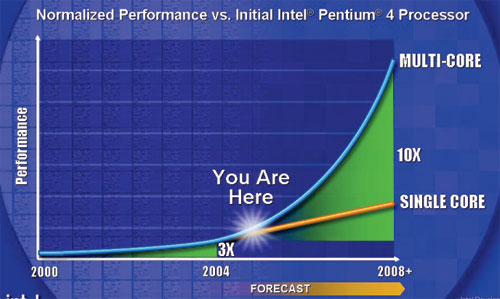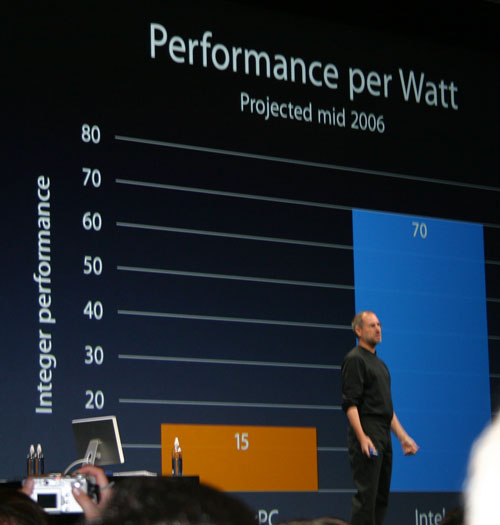Intel's Core 2 Extreme QX6700: The Multi-core Era Begins
by Anand Lal Shimpi on November 2, 2006 2:14 AM EST- Posted in
- CPUs
More Cores - The Ticket to Power Efficiency?
When Intel started on its quest for greater power efficiency we heard much about how the ticket would be more cores and multi-threaded applications. Instead of focusing on increasing clock speed Intel turned to the world and admitted that its gigahertz race was foolish, and that the next decade of performance improvements would come from increasing the number of cores per processor, not clock speed.
Back in 2005 Intel displayed the following chart, plotting a new curve for performance made possible mostly by the move to multi-core processors:

But at the same time, just as Intel had learned from the Pentium 4 family, an endless pursuit of performance (whether in the form of higher clock speed or more cores) will simply run us into another power wall. So as we were hearing about the performance improvements the multi-core era would bring us, we were also being told that Intel would not only improve the performance vector, but performance-per-watt as well. In fact, Apple cited Intel's focus on performance-per-watt as the driving factor in its adoption of Intel CPUs:

The introduction of Intel's Core microarchitecture proved one very important point: individual core improvements, as well as simply adding more cores, will both be necessary to drive better performance per watt in future microprocessors.
Looking at Intel's own numbers, the move from one to two cores improved performance per watt on the mobile side by around 50% while the move from NetBurst to Core on the desktop side increased performance per watt by a magnitude of 5x.
But is Kentsfield nothing more than a cleverly masked return to an older Intel? An Intel that used its manufacturing abilities to out-market AMD but left us with much higher power consumption than we wanted (and needed) to have? With Kentsfield we have two Conroes on a single chip, with no tweaks to the cores and very inefficient power management between the two die. Is this really no different than when Intel simply pushed out CPUs with higher clock frequencies, without addressing efficiency, to really turn up the heat on AMD?
Intel has said that it is committed to improving performance and performance per watt, but it was time to test that commitment with Kentsfield.
To put Intel's marketing and IDF presentations to the test we took six of our multithreaded benchmarks and ran them on a handful of configurations. Instead of just measuring performance, we also looked at average power usage during the benchmark and obviously, performance per watt. While all six benchmarks benefit from dual core CPUs, only four of them show a gain when using a quad core CPU, which should be useful in illustrating a very important correlation between number of threads and performance per watt.










59 Comments
View All Comments
PrinceGaz - Thursday, November 2, 2006 - link
What do you mean it is "a insanely round-about way of measuring power draw"? Can you come up with a better one that doesn't involve cutting tracks on mobos to read the current being passed through them? Or a method which would work equally well with very soon to be released G80 graphics-core which is reputed to dissipate rather a lot of heat (clamp the water-block on that G80 and we'll soon see how much heat it really puts out).If you can come up with a simpler and better method of determining the power usage of CPUs and other devices, feel free to divulge the details here because their current method of measuring at the AC power-outlet is woefully inadequate, and I think a water-block heat-transfer system is not only a simple but quite accurate way of measuring power use, but one that can be applied to both CPUs and GPUs.
autoboy - Thursday, November 2, 2006 - link
Wow, all you guys have really weird methods of measuring power draw. Nearly all the power for modern processors comes through the 12V Aux power connector. You can measure the current and voltage here and you will get the power consumption of the processor. However, the efficiency of the VRM can skew the results slightly.Gigahertz19 - Thursday, November 2, 2006 - link
Ah I like the little hint on the transitor count for Nividia's G80 when they release next week. Can't wait till Nvidia's G80 is released and we get some benchies :)
fikimiki - Thursday, November 2, 2006 - link
Looking at pure encoding performance we can expect only 40-50% increase.It is very,very bad.
Why don't you compare this CPU with Dual-Core Opteron platform?
Without better cache management this CPU is only for benchmarks same as 4x4 it's with crazy pricing.
defter - Thursday, November 2, 2006 - link
Why compare cheaper single-socket platform with more expensive dual-socket platform?
Are you kidding? Kentsfield PC will be cheaper than 4x4 PC, if Kentsfield will achieve same level of performance, then it will have better price/performance ratio.
lopri - Thursday, November 2, 2006 - link
Damn.. I can't get over how gigantic those dice look together.msva124 - Thursday, November 2, 2006 - link
Is the article fully uploaded yet? I got some 404s as I was reading through it.xFlankerx - Thursday, November 2, 2006 - link
Fine for me now. NIce stuff too, as has come to be expected from AT.Chuske - Monday, December 25, 2017 - link
I come from the FUTURE !! In very late 2017, beggining of 2018, quad core CPUs are still very much in use .. even QX6700 and people favourite Q6600 (10$ now) held pretty well, for 11 yo cpus ..